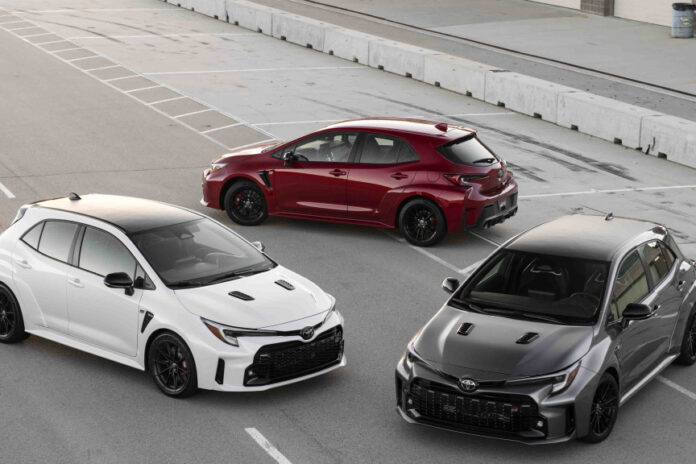Nerve-car enthusiasts can breathe, the breed is not extinct. After the Elantra N, Golf R and Civic Type R, it’s Toyota’s turn to launch the GR Corolla. This new model, whose production rate will be limited, also aims to give tonicity to the entire range and to take advantage of the successes achieved in competition.
Some people will confuse it with a Corolla hatchback. Look at her better. The GR Corolla is distinguished by subtle bodywork details, wider tires and enveloping front seats that perfectly support the driver and his passenger. The linkages are slightly stiffer and the power steering is more direct to suit a livelier ride.
This throttle horn invites you to rev up and play the six-speed gearbox, letting out a nice throaty tone. Glued to the road, this Toyota composes a universe without frills. Firmly suspended, this GR Corolla houses a 1.6L three-cylinder engine under its hood. to leap. And you don’t have to drive fast to get thrills.
Packed with mechanical power, the GR Corolla is not a nerve-wracking machine in the truest sense of the word. At least not in its Core and Circuit versions. The Morizo, lower, more sophisticated and more “torquey” too, is more so, but its rarity (a handful of copies offered and they have all been sold already) makes it a model apart.
Regardless of the livery, acceleration is brisk without being snappy, but since the car weighs less than 1,500 kg, the 300 hp make their presence felt. There is no need to look for it, the automatic box does not exist, only a six-speed manual transmission is offered. The latter is easily guided in sporty driving, but proves to be a little catchy at low speeds. In this area, Honda does better (Civic Type R) and Volkswagen, much worse (Golf R). On the consumption side, the engineers have limited the damage. Just 10 L per 100 km, keeping the foot light.
If you want to make the tires squeal, you have to push hard. It’s perhaps less spectacular, but infinitely more pleasant and reassuring for anyone who doesn’t pretend to compare themselves to a rally driver.
On this subject, it is important to remember that this Corolla has four-wheel drive, which allows for certain adjustments. Indeed, the distribution of torque towards the rear part of the chassis is carried out thanks to a multi-disc clutch. The sports subsidiary of Toyota allows, using a wheel on the console, to distribute up to 70% on the rear axle. You can also select a more neutral (50/50) or less exacerbated (60/40) transfer.
As for braking, particularly biting, it is very effective, while the suspensions, hardened to prevent any movement of the body, gain in firmness without their reinforced calibration making them pour into discomfort. A compliment that passengers will not necessarily share…
Conceived as a manifesto dedicated to the pleasure of driving, the GR Corolla is content with a cabin without grace. The driver is strapped into his seat with side reinforcements (with GR stitching), the pedals (with aluminum caps) under his feet. The steering wheel well in hand and the tachometer discreetly streaked with red under the eyes are enough to convince him that he does not drive a Corolla like the others. Very readable, the tachometer with digital display has been conveniently placed in its field of vision. This is embellished with setting options, which allow in particular to display the thrust of the turbo or to monitor the temperature of the main mechanical components.
The small racing car that is the GR would, despite everything, deserve an improved interior and, above all, more cheerful than that of the other Corollas. The interior linings are in black plastic and no fantasy comes to light up the somewhat chagrin atmosphere that reigns on board this toy yet intended to celebrate a form of automotive vitality. Even in sports gear, the Corolla remains an introverted car.
La Presse will soon publish the test of the following vehicles: Audi RS7, Buick Encore, Porsche Cayenne and Toyota Highlander. If you own one of these vehicles or are considering one, we would love to hear from you.
From $48,604 to $57,104 (Core and Circuit)
10.1L/100km
Far, but very far from the beige Corolla
You have before you a glimpse of the most powerful three-cylinder engine ever produced in series. This engine produces 300 hp here, but several independent tuners have been able to increase this to 741 hp. This was made possible in particular with the use of a new turbocharger, overhauling the exhaust manifold and modifying the electronic management. The pistons, the crankshaft and the connecting rods have surprisingly not been retouched. Toyota engine designers are also exploring ways to achieve better performance. The Morizo version of the GR Corolla, for example, boasts higher boost pressure than the Core and Circuit.
On May 27 and 28, a liquid hydrogen-powered GR Corolla crossed the checkered flag of the Fuji 24 Hours. For the record, the Japanese manufacturer had already entered a similar model in competition in 2021, but it then used gaseous hydrogen, the energy density of which was lower and the range less. Switching to liquid hydrogen did not speed up filling, however. It takes about 90 seconds to refuel. In contrast, the equipment previously required to produce compressed hydrogen gas is no longer required. As a result, the area required to install the refueling station is four times smaller compared to that for hydrogen gas.















